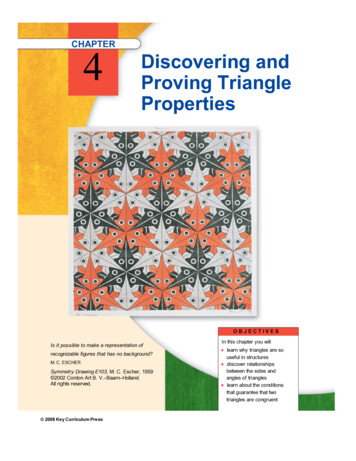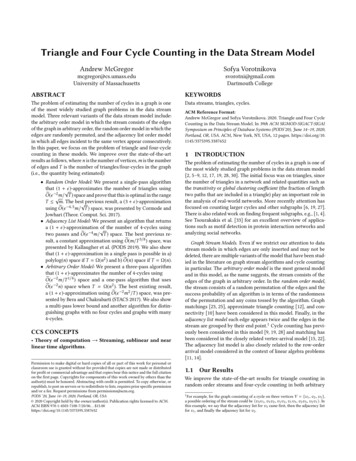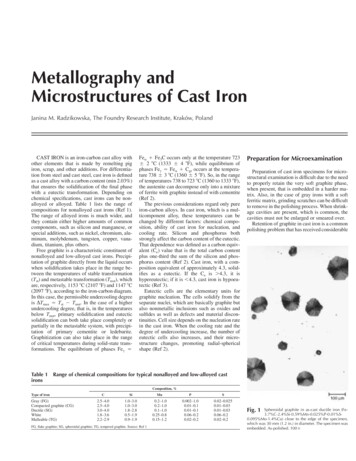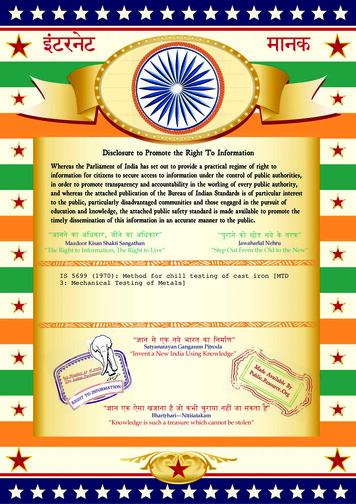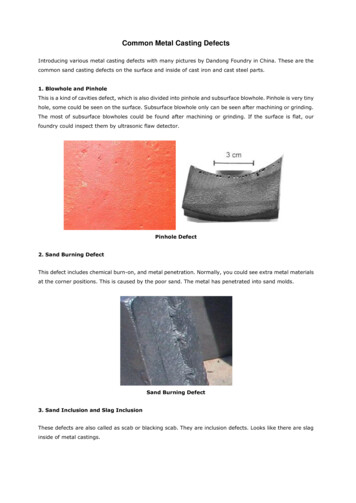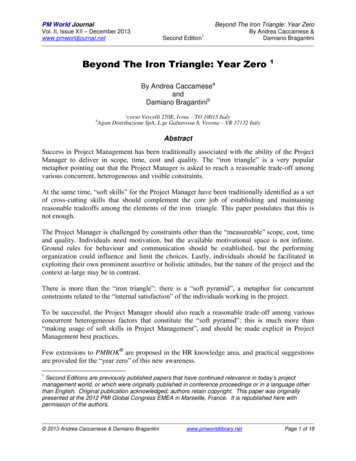
Transcription
PM World JournalBeyond The Iron Triangle: Year ZeroVol. II, Issue XII – December 2013www.pmworldjournal.netSecond Edition1By Andrea Caccamese &Damiano BragantiniBeyond The Iron Triangle: Year Zero1By Andrea CaccameseaandDamiano Bragantinibacorso Vercelli 270E, Ivrea – TO 10015 ItalyAgsm Distribuzione SpA, L.ge Galtarossa 8, Verona – VR 37132 ItalybAbstractSuccess in Project Management has been traditionally associated with the ability of the ProjectManager to deliver in scope, time, cost and quality. The “iron triangle” is a very popularmetaphor pointing out that the Project Manager is asked to reach a reasonable trade-off amongvarious concurrent, heterogeneous and visible constraints.At the same time, “soft skills” for the Project Manager have been traditionally identified as a setof cross-cutting skills that should complement the core job of establishing and maintainingreasonable tradeoffs among the elements of the iron triangle. This paper postulates that this isnot enough.The Project Manager is challenged by constraints other than the “measureable” scope, cost, timeand quality. Individuals need motivation, but the available motivational space is not infinite.Ground rules for behaviour and communication should be established, but the performingorganization could influence and limit the choices. Lastly, individuals should be facilitated inexploiting their own prominent assertive or holistic attitudes, but the nature of the project and thecontext at-large may be in contrast.There is more than the “iron triangle”: there is a “soft pyramid”, a metaphor for concurrentconstraints related to the “internal satisfaction” of the individuals working in the project.To be successful, the Project Manager should also reach a reasonable trade-off among variousconcurrent heterogeneous factors that constitute the “soft pyramid”: this is much more than“making usage of soft skills in Project Management”, and should be made explicit in ProjectManagement best practices.Few extensions to PMBOK are proposed in the HR knowledge area, and practical suggestionsare provided for the “year zero” of this new awareness.1Second Editions are previously published papers that have continued relevance in today’s projectmanagement world, or which were originally published in conference proceedings or in a language otherthan English. Original publication acknowledged; authors retain copyright. This paper was originallypresented at the 2012 PMI Global Congress EMEA in Marseille, France. It is republished here withpermission of the authors. 2013 Andrea Caccamese & Damiano Bragantiniwww.pmworldlibrary.netPage 1 of 18
PM World JournalBeyond The Iron Triangle: Year ZeroVol. II, Issue XII – December 2013www.pmworldjournal.netSecond Edition1By Andrea Caccamese &Damiano BragantiniProject SuccessWhat makes a project successful? Customer satisfaction? Being on time? Minimizing changes?Being on budget?This question is well answered when reference to “management by projects” is made.Management by projects is an organizational model which is adopted by those organizationsrecognizing that their ability to produce value for stakeholders depends greatly on theircapability to execute good projects. In this approach, the interest is shifted from the limitedability to deliver the product of the project, to an expanded view in which projects are consideredthe enablers for change and associated organizational benefits, then to a view in projectportfolios are considered the way in which the organization translates in tangible efforts itsstrategic plan.In this view, projects, programs and project portfolios represent the space for connected levels oforganizational project management, in which project management practices are complementedwith practices of benefits identification, planning, delivering and tracking (programmanagement) and with practices dealing with the goal to maximize capital investment incomparison with the value represented by a projects portfolio.Then (Morris, Pinto, 2004), as in Exhibit 1, project success spans in a continuum in whichproject management success (was the project done right?) is complemented with project success(was the right project done?), to project portfolio management success (were the right projectsdone, time after time?).Exhibit 1 - The three levels of project successConsideration should be given to the fact that for each of these levels, project success ismeasured with numerical indicators related to the “external projection” of the project (in linewith the semantics of to project). Project management success may be measured in terms ofcumulative values of earned value method, CPI and SPI. Project success may be measured in 2013 Andrea Caccamese & Damiano Bragantiniwww.pmworldlibrary.netPage 2 of 18
PM World JournalVol. II, Issue XII – December 2013www.pmworldjournal.netBeyond The Iron Triangle: Year ZeroSecond EditionBy Andrea Caccamese &Damiano Bragantini1terms of benefits, changes of numeric values related to the organization business when theproject’s product has been delivered and incorporated in the organization’s practices andprocedures.Project portfolio management success may be measured in terms of the distance of the activeproject portfolio from the efficient frontier, the curve whose points represent the portfoliostructure delivering the maximum value for each value of the invested capital (Levine, 2005).Popular project management standards are quite well aligned with this view of project success.Project Management Institute (PMI) A Guide to the Project Management Body of Knowledge(PMBOK) (PMI, 2008) depicts as in Exhibit 2 the distribution of various levels of projectsuccess:SuccessPROJECTSSuccess is measured byproduct and projectquality, timeliness, budgetcompliance, and degree ofcustomer satisfaction.PROGRAMSSuccess is measured bythe degree to which theprogram satisfies theneeds and benefits forwhich it was undertaken.PORTFOLIOSSuccess is measured interms of aggregateperformance of portfoliocomponents.Exhibit 2 - Levels of project success according to PMBOK Fourth EditionThe Organization for Government Commerce (OGC) in their Managing Successful Project withPrince2 (OGC, 2009) hold the Project Manager accountable for staying in the tolerancesassigned in the project definition (project management success), and leaves to post-projectactivities the task to track and measure project benefits (project success). In ManagingSuccessful Programs(OGC, 2008) a clear definition is also made for program success in terms ofthe ability to derive from project outputs specific outcomes that in turn produce changesperceived as measurable benefits.The International Project Management Association (IPMA) in their IPMA Competence Baseline(IPMA, 2006)state that project success relates strictly to project management success, as the ability to deliverthe project’s product in scope, time, cost and quality.Then, there is general consensus upon what constitutes project management success, and uponthe “external” nature of the indicators chosen to measure and evaluate project managementsuccess.In the following sections, integration to this view will be proposed.Defining “successful project management” an endeavour hitting targets related to the “externalprojection” of the project might be restrictive. If consideration is given to the fact that duringher/his limited and temporary tenure the Project Manager deals mainly with the project team, 2013 Andrea Caccamese & Damiano Bragantiniwww.pmworldlibrary.netPage 3 of 18
PM World JournalBeyond The Iron Triangle: Year ZeroVol. II, Issue XII – December 2013www.pmworldjournal.netSecond EditionBy Andrea Caccamese &Damiano Bragantini1made of individuals, each of them bringing inclinations, attitudes and expectations, then othergoals may be defined for a “successful project management”, related to “internal projection” ofthe project.Extended Metaphor of Project Management SuccessProject management focuses upon the ability to deliver the project’s product in scope, time, costand quality. There are many other requirements for a good project management, someconcerning with the ability to control the level of uncertainty in project, some related toestablishing and maintaining appropriate communications channels, and much more. What isevident upon scope, time, cost and quality is that they establish a system of constraints for theproject manager, who is called to manage a set of interrelated elements, of very different nature,in a context that usually limits the degree of freedom that can be exercised. The project manageris requested to define, establish and maintain a trade-off among interrelated constraints ofheterogeneous nature (Kerzner, 2009). The “iron triangle”, as in Exhibit 3, is a popularmetaphor which identifies quite well the integrative role of the project manager (Atkinson,1999), (Bernroider, Ivanov, 2011), (Toor, Ongulana, 2010).TIMEQUALITYSCOPECOSTExhibit 3 – The traditional iron triangleProject management success is therefore related to the ability of the project manager to identify,negotiate, mediate and integrate diverse constraints in light of which the project is carried on.However, other factors indeed interfere with the action of the project manager. Modern projectsare made by individuals, whose action is instrumental for project success. Maintenance factorslike team spirit, personal involvement, openness to teamwork, belong on one side to the sphereof individuals, and on the other side they constitute a collective spirit that is a primary resourcefor the project, as well task factors like man-hours, tools, technologies, processes and materials.Traditionally this has been incorporated in project management through the concept of “softskills”, that the project manager is expected to employ in a cross-cutting approach, thereforecompleting the usage of “hard skills”, like estimation techniques, cost control, schedulingtechniques and much more. 2013 Andrea Caccamese & Damiano Bragantiniwww.pmworldlibrary.netPage 4 of 18
PM World JournalVol. II, Issue XII – December 2013www.pmworldjournal.netBeyond The Iron Triangle: Year ZeroSecond Edition1By Andrea Caccamese &Damiano BragantiniBut considering “soft skills” just as important attributes that the project manager is expected toemploy in the main task of finding a trade-off among the components of the iron triangle, justleads to a set of good advices and reasonable suggestions, like “be yourself”, “pay attention toteam members as individuals”, “be emphatic”, “communicate well”. This seems too simplistic,the underlying assumption that it is just matter of having those “soft skills”, or preparing to havethe right level of those “soft skills”, might prove false.For example, “soft skills” enable the project manager to facilitate communication among projectmembers: but too often the fact that the project is originated by a performing organization thatmight influence the project with its culture, procedures and policies, is underestimated. If theculture of the performing organization related to communication is strongly oriented tostructured and hierarchical communication channels, this at some extent might be a constraint fora project manager willing to establish open and ease communication among team members.For example, “soft skills” enable the project manager to motivate individuals, according to theirneeds. But if the project is a “familiar” project, or it is executed with a “captive” customer, thismight be at some extent a constraint for a project manager willing to represent to “highperformers” that the project is a good answer to their expectations for growth. Many othersimilar examples raise the observation that project management deals with “soft factors” thatexist into limited spaces, exactly like “hard factors” (scope, time, cost and quality) exist intolimited spaces. Being those spaces limited, the “soft factors” establish for the project manager afurther system of constraints.Exhibit 4 depicts the “spaces for soft factors” as the interconnected sides of a triangular pyramid: ABV: motivational space. This is the space available for the project to activate thecontext for individual motivation. For example, like working conditions, job security,advancement, growth, power, affiliation, esteem, decision-making processes, rewardingsystems (Verma, 1995); ACV: social space. This is the space available for the project to activate the protocols foracceptable behaviour. These are made of both task-related rules as well as social rules,like punctuality in task completion, agreed time to read and respond to messages, respectof consensus decisions, honesty, truth, preparation for and attendance to meetings,punctuality on meetings (Whatley, 2009); BCV: analytic/holistic space. This is the space available for the project to foster andfacilitate the development of individual thinking models. The analytic model is centredupon analysis, linearity, sequentiality, reductionism and places high value uponexpansion, competition, quantity and assertiveness. The holistic model is centred uponsynthesis, non linearity, parallelism, holism and places high value upon preservation,cooperation, quality and associationism (Capra, 1982). 2013 Andrea Caccamese & Damiano Bragantiniwww.pmworldlibrary.netPage 5 of 18
PM World JournalBeyond The Iron Triangle: Year ZeroVol. II, Issue XII – December 2013www.pmworldjournal.netSecond Edition1By Andrea Caccamese &Damiano BragantiniExhibit 4 - The “soft factors” of the projectThe spaces as defined above differ from the spaces for “hard” factors (which are traditionallyrepresented by segments, then mono-dimensional), in that their attributes are not onlyquantitative, rather they have also “qualitative” attributes (and in fact they are represented bysurfaces, then bi-dimensional). For example, all dollars summing up the project budget are thesame. But all the motivation summing up the project motivation is not the same. While to run aproject you need a definite amount of dollars (the cost space), to run a project you need a definiteamount of motivation of some kind (the motivational space): then you need a certain amount ofmotivation distributed among different qualitative quotas.Just like hard spaces, soft spaces in project management are constrained by the context, theorganization, and the project characteristics.But soft spaces also experience interrelated constraints; exactly like “hard” factors areinterrelated, e.g. the project manager cannot define whatever scope for the project since thiswould involve a space for project cost that might not be available, the same happens for “soft”factors.The project might have a quite big space for motivational factors, useful for example to motivateindividuals looking for recognition, respect and esteem. In this view, the project manager couldoffer to specific individuals challenging tasks, requiring a high level of individual autonomy,without strict needs of reporting, sharing, and coordination. But, on the other side, the socialspace available for the project could not be adequate to support what involved by a bigmotivational space of that kind. As an example, a high technology project run in a highlystructured customer/supplier environment, might give the possibility to let “wild horses” run, buton the other side in this context there might be high attention to reporting, disciplined sharing ofwork results, and maybe a quite big number of meetings.The project might have a quite big analytic/holistic space, useful for example to promote analyticattitudes of individuals devoted to details. In this context, the project manager could support the“analysts” working in the project, authorizing individual activities requiring deep application of 2013 Andrea Caccamese & Damiano Bragantiniwww.pmworldlibrary.netPage 6 of 18
PM World JournalBeyond The Iron Triangle: Year ZeroVol. II, Issue XII – December 2013www.pmworldjournal.netSecond EditionBy Andrea Caccamese &Damiano Bragantini1Cartesian scientific method. But, on the other side, the motivational space available for theproject could not be adequate to support what involved by an analytic/holistic space of that kind.For example, a research project run in a cultural or professional association environment, mightgive the possibility to support analytic attitudes, but in this context sense of belonging and beingpart of a club might be also fundamental, and they might be valued more than individualexcellence.Finally, there are also interdependencies between the “soft factors” and the “hard factors” inproject management.It is not possible to make usage of big portions of an available motivational space, even if this isbalanced and in line with the social space and analytic/holistic space, if this involves excessiveportions of “hard space”. As an example, a big (even available and balanced) motivational spacecould not be selected if this implies portions of cost and time spaces that are not available.Then, “hard factors” and “soft factors” constitute a system of constraints that may be representedin a three dimensional view as in Exhibit 5, where a “soft pyramid” rests upon the traditional“iron triangle”:TIMEQUALITYSCOPE COSTExhibit 5 - The soft pyramid and the iron triangleThere is a need for the project manager to find appropriate tradeoffs and balance among and withthe “soft factors”, thus looking at the project through an “internal projection” and working onfactors that relate to the personal and interpersonal sphere, complementing the traditional view,oriented to an “external projection” and to “hard” factors. Based on this, it seems quite obviousto reconsider the traditional paradigm of project success, complementing the activity ofintegrating and balancing “hard” factors with an activity of integrating and balancing “soft”factors, and “hard” factors with “soft” factors as well. Good project management in this view ismore than delivering in scope, time, and quality and cost, rather it implies also the ability to 2013 Andrea Caccamese & Damiano Bragantiniwww.pmworldlibrary.netPage 7 of 18
PM World JournalBeyond The Iron Triangle: Year ZeroVol. II, Issue XII – December 2013www.pmworldjournal.netSecond Edition1By Andrea Caccamese &Damiano Bragantinimanage a set of interrelated constraints, with the aim to create a project climate in which thevarious personalities working in the project may develop their own peculiarities in state ofinternal satisfaction. Then, project management success is not only building and maintaining theiron triangle, rather it also needs approaching in a structured way the issue to grow and respectteam member personalities in a constrained environment.Analytic/holistic space and project management teamThe motivational space and the social space are not new concepts in project management: whendealing with “soft skills” it is quite usual to mention the ability to motivate and the ability toprovide norms and rules appropriate for fostering project team development. The concept of ananalytic/holistic space in project management is less popular, however.A recent research (Dondana, 2010) has been performed on an extended population of projectmanagers of both sexes across diverse industries and territories. A comprehensive questionnairewas distributed, with the aim to gather the kind of approach, (holistic/integrative/feminine oranalytic/assertive/masculine) taken by the project manager when executing tasks according toPMBOK knowledge areas (PMI, 2008) and using competencies according to PMCDF PMI,2007). One of the main results of the research is shown in Exhibit 6:Exhibit 6 – Distribution of attitudes in Project ManagementThis picture shows the percentage of project managers adopting strongly analytic or stronglyholistic approaches, and indeed it provides quite a number of surprises. For example, it issurprising that Cost Management, which should involve mostly usage of a strong analyticap
Project management focuses upon the ability to deliver the project’s product in scope, time, cost and quality. There are many other requirements for a good project management, some . Exhibit 4 depicts the “spaces for soft factors” as the interconnected sides of a triangular pyramid:
